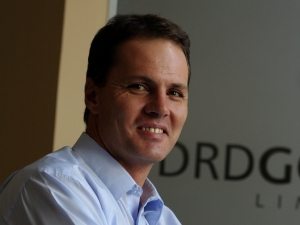
[miningmx.com] — DRDGOLD CEO Niel Pretorius is in London, selling the virtues of the lower risk, higher margin Johannesburg-based gold company that he runs.
The company is one of the oldest listings on the JSE and has a colourful history, especially when it was under the control of the Kebbles and their bete noir, former CEO Mark Wellesley-Wood.
Today DRDGold is a transformed entity. It no longer mines underground and Pretorius and his team have spent the last seven years transforming it into a tailings treatment company.
In common with other gold producers, DRDGold, which reported its third quarter earnings on Thursday, said its costs have been rising. In the three months they climbed 22%, mainly due to higher electricity and wage costs.
Over the same period, DRD increased gold production by 3% and lifted revenue by 16% to R531m. It recorded headline earnings of 14c.
“As our strategic capital commitments come to an end, we remain focused on maximising the operating and financial capabilities of the Brakpan plant’s CIL [carbon in leach] circuit,’ the company said. “A key element here is improved productivity, both at operational and individual employee level.’
Investment in that carbon leach plant should be completed by the end of this year. DRDGold hopes more money will then flow through to shareholders in the form of dividends. Pretorius said it has a target dividend yield of 4% to 5%.
The company also intends to boost its research and development spend in an effort to discover more efficient ways to extract gold from old mine waste materials.
Pretorius said of the material recycled, using current technology, the company still only manages to leach out about 50% of the gold contained in the waste.
“We need to find the technology to unlock this. We have never spent any serious money on research and development [and] going forward we are going to spend more money, bringing in external expertise and analysis,’ he said.
One gold analyst, who declined to be named, said a great deal would have to be invested to make the technological breakthrough necessary to extract significantly more gold from the dumps.
“The quantum change would have to be substantial. It’s like getting an extra ant off an elephants back.’
DRD today is a bit of a hybrid – part miner, recycler, engineering and technology company.
Pretorius wants to promote the positives about the company’s strategy to win longer-term investors.
“We want the model to settle in and want to make sure we attract shareholders who understand the long-term fundamentals of the company,’ he said.
Compared to mining gold, especially in South Africa where deep level mining brings many challenges, recycling gold from waste dumps is a much lower risk operation, something that gold investors would welcome.
“It’s a good model and they are sticking to their knitting. If they improve the technology it could bring dividends,’ said the analyst.
Through the sale of its property in Zimbabwe, DRD wants to regain the R40m it invested in the exploration of the gold-bearing greenstone site. It decided not to take it any further as Pretorius said the ore was too deep.
Also the company is looking at some dumps in Zimbabwe that may, in time, be recycled. Previously this had been difficult because of the nature of the waste, but Pretorius said the company’s “fine grind’ technology could do this perhaps.
“[We would look at Zimbabwean dumps] only after we have seen what the “fine grind’ technology opens up for us,’ he said.











